SDN上机第三次作业
1. 利用Mininet仿真平台构建如下图所示的网络拓扑,配置主机h1和h2的IP地址(h1:10.0.0.1,h2:10.0.0.2),测试两台主机之间的网络连通性

使用miniedit进行创建操作,前两次均用到了,不再赘述,给出自己的操作图片。



2. 利用Wireshark工具,捕获拓扑中交换机与控制器之间的通信数据,对OpenFlow协议类型的各类报文(hello, features_request, features_reply, set_config, packet_in, packet_out等)进行分析,对照wireshark截图写出你的分析内容。
1.hello
控制器6633端口(最高能支持OpenFlow 1.0) ---> 交换机32862端口

交换机32862端口(最高能支持OpenFlow 1.3)--- 控制器6633端口

于是双方建立连接,并使用OpenFlow 1.0
2.Features Request
控制器6633端口(需要特征信息) ---> 交换机32862端口

3.Set Config
控制器6633端口(请按照我给你的flag和max bytes of packet进行配置) ---> 交换机32862端口

4.Features Reply
交换机32862端口(这是我的特征信息,请查收)--- 控制器6633端口

Features 消息包括 OpenFlow Header 和 Features Reply Message
对照Features Reply Message结构
struct ofp_switch_features{
struct ofp_header header;
uint64_t datapath_id; /*唯一标识 id 号*/
uint32_t n_buffers; /*交缓冲区可以缓存的最大数据包个数*/
uint8_t n_tables; /*流表数量*/
uint8_t pad[3]; /*align to 64 bits*/
uint32_t capabilities; /*支持的特殊功能,具体见 ofp_capabilities*/
uint32_t actions; /*支持的动作,具体见 ofp_actions_type*/
struct ofp_phy_port ports[0]; /*物理端口描述列表,具体见 ofp_phy_port*/
};
对应到抓取到的报文,逐项查看报文内容
OpenFlow 1.0
.000 0001 = Version: 1.0 (0x01)
Type: OFPT_FEATURES_REPLY (6)
Length: 176
Transaction ID: 1804683928
Datapath unique ID: 0x0000000000000002
MAC addr: 00:00:00_00:00:00 (00:00:00:00:00:00)
Implementers part: 0x0002
n_buffers: 0
n_tables: 254
Pad: 000000
capabilities: 0x000000c7
.... .... .... .... .... .... .... ...1 = Flow statistics: True
.... .... .... .... .... .... .... ..1. = Table statistics: True
.... .... .... .... .... .... .... .1.. = Port statistics: True
.... .... .... .... .... .... .... 0... = Group statistics: False
.... .... .... .... .... .... ..0. .... = Can reassemble IP fragments: False
.... .... .... .... .... .... .1.. .... = Queue statistics: True
.... .... .... .... .... ...0 .... .... = Switch will block looping ports: False
actions: 0x00000fff
.... .... .... .... .... .... .... ...1 = Output to switch port: True
.... .... .... .... .... .... .... ..1. = Set the 802.1q VLAN id: True
.... .... .... .... .... .... .... .1.. = Set the 802.1q priority: True
.... .... .... .... .... .... .... 1... = Strip the 802.1q header: True
.... .... .... .... .... .... ...1 .... = Ethernet source address: True
.... .... .... .... .... .... ..1. .... = Ethernet destination address: True
.... .... .... .... .... .... .1.. .... = IP source address: True
.... .... .... .... .... .... 1... .... = IP destination address: True
.... .... .... .... .... ...1 .... .... = IP ToS (DSCP field, 6 bits): True
.... .... .... .... .... ..1. .... .... = TCP/UDP source port: True
.... .... .... .... .... .1.. .... .... = TCP/UDP destination port: True
.... .... .... .... .... 1... .... .... = Output to queue: True
Port data 1
Port number: 65534
HW Address: 26:97:c9:61:e4:1e (26:97:c9:61:e4:1e)
Port Name: s2
Config flags: 0x00000001
.... .... .... .... .... .... .... ...1 = Port is administratively down: True
.... .... .... .... .... .... .... ..0. = Disable 802.1D spanning tree on port: False
.... .... .... .... .... .... .... .0.. = Drop all packets except 802.1D spanning tree packets: False
.... .... .... .... .... .... .... 0... = Drop received 802.1D STP packets: False
.... .... .... .... .... .... ...0 .... = Do not include this port when flooding: False
.... .... .... .... .... .... ..0. .... = Drop packets forwarded to port: False
.... .... .... .... .... .... .0.. .... = Do not send packet-in msgs for port: False
State flags: 0x00000001
.... .... .... .... .... .... .... ...1 = No physical link present: True
Current features: 0x00000000
.... .... .... .... .... .... .... ...0 = 10 Mb half-duplex rate support: False
.... .... .... .... .... .... .... ..0. = 10 Mb full-duplex rate support: False
.... .... .... .... .... .... .... .0.. = 100 Mb half-duplex rate support: False
.... .... .... .... .... .... .... 0... = 100 Mb full-duplex rate support: False
.... .... .... .... .... .... ...0 .... = 1 Gb half-duplex rate support: False
.... .... .... .... .... .... ..0. .... = 1 Gb full-duplex rate support: False
.... .... .... .... .... .... .0.. .... = 10 Gb full-duplex rate support: False
.... .... .... .... .... .... 0... .... = Copper medium: False
.... .... .... .... .... ...0 .... .... = Fiber medium: False
.... .... .... .... .... ..0. .... .... = Auto-negotiation: False
.... .... .... .... .... .0.. .... .... = Pause: False
.... .... .... .... .... 0... .... .... = Asymmetric pause: False
Advertised features: 0x00000000
Features supported: 0x00000000
Features advertised by peer: 0x00000000
Port data 2
Port number: 1
HW Address: 72:17:f0:28:7b:5e (72:17:f0:28:7b:5e)
Port Name: s2-eth1
Config flags: 0x00000000
.... .... .... .... .... .... .... ...0 = Port is administratively down: False
.... .... .... .... .... .... .... ..0. = Disable 802.1D spanning tree on port: False
.... .... .... .... .... .... .... .0.. = Drop all packets except 802.1D spanning tree packets: False
.... .... .... .... .... .... .... 0... = Drop received 802.1D STP packets: False
.... .... .... .... .... .... ...0 .... = Do not include this port when flooding: False
.... .... .... .... .... .... ..0. .... = Drop packets forwarded to port: False
.... .... .... .... .... .... .0.. .... = Do not send packet-in msgs for port: False
State flags: 0x00000000
.... .... .... .... .... .... .... ...0 = No physical link present: False
Current features: 0x000000c0
.... .... .... .... .... .... .... ...0 = 10 Mb half-duplex rate support: False
.... .... .... .... .... .... .... ..0. = 10 Mb full-duplex rate support: False
.... .... .... .... .... .... .... .0.. = 100 Mb half-duplex rate support: False
.... .... .... .... .... .... .... 0... = 100 Mb full-duplex rate support: False
.... .... .... .... .... .... ...0 .... = 1 Gb half-duplex rate support: False
.... .... .... .... .... .... ..0. .... = 1 Gb full-duplex rate support: False
.... .... .... .... .... .... .1.. .... = 10 Gb full-duplex rate support: True
.... .... .... .... .... .... 1... .... = Copper medium: True
.... .... .... .... .... ...0 .... .... = Fiber medium: False
.... .... .... .... .... ..0. .... .... = Auto-negotiation: False
.... .... .... .... .... .0.. .... .... = Pause: False
.... .... .... .... .... 0... .... .... = Asymmetric pause: False
Advertised features: 0x00000000
Features supported: 0x00000000
Features advertised by peer: 0x00000000
Port data 3
Port number: 2
HW Address: 2a:e8:0b:d1:58:7b (2a:e8:0b:d1:58:7b)
Port Name: s2-eth2
Config flags: 0x00000000
.... .... .... .... .... .... .... ...0 = Port is administratively down: False
.... .... .... .... .... .... .... ..0. = Disable 802.1D spanning tree on port: False
.... .... .... .... .... .... .... .0.. = Drop all packets except 802.1D spanning tree packets: False
.... .... .... .... .... .... .... 0... = Drop received 802.1D STP packets: False
.... .... .... .... .... .... ...0 .... = Do not include this port when flooding: False
.... .... .... .... .... .... ..0. .... = Drop packets forwarded to port: False
.... .... .... .... .... .... .0.. .... = Do not send packet-in msgs for port: False
State flags: 0x00000000
.... .... .... .... .... .... .... ...0 = No physical link present: False
Current features: 0x000000c0
.... .... .... .... .... .... .... ...0 = 10 Mb half-duplex rate support: False
.... .... .... .... .... .... .... ..0. = 10 Mb full-duplex rate support: False
.... .... .... .... .... .... .... .0.. = 100 Mb half-duplex rate support: False
.... .... .... .... .... .... .... 0... = 100 Mb full-duplex rate support: False
.... .... .... .... .... .... ...0 .... = 1 Gb half-duplex rate support: False
.... .... .... .... .... .... ..0. .... = 1 Gb full-duplex rate support: False
.... .... .... .... .... .... .1.. .... = 10 Gb full-duplex rate support: True
.... .... .... .... .... .... 1... .... = Copper medium: True
.... .... .... .... .... ...0 .... .... = Fiber medium: False
.... .... .... .... .... ..0. .... .... = Auto-negotiation: False
.... .... .... .... .... .0.. .... .... = Pause: False
.... .... .... .... .... 0... .... .... = Asymmetric pause: False
Advertised features: 0x00000000
Features supported: 0x00000000
Features advertised by peer: 0x00000000
5.Packet_in
交换机32864端口(有数据包进来,请指示)--- 控制器6633端口
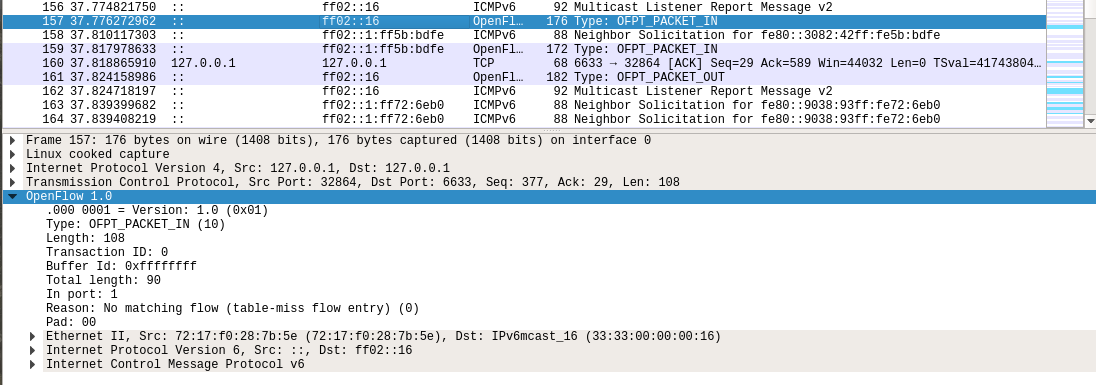
结合Packet_in的结构
struct ofp_packet_in {
struct ofp_header header;
uint32_t buffer_id; /*Packet-in消息所携带的数据包在交换机缓存区中的ID*/
uint16_t total_len; /*data字段的长度*/
uint16_t in_port; /*数据包进入交换机时的端口号*/
uint8_t reason; /*发送Packet-in消息的原因,具体见 ofp_packet_in_reason*/
uint8_t pad;
uint8_t data[0]; /*携带的数据包*/
};
分析抓取的数据包,可以发现是因为交换机发现此时自己并没有匹配的流表(Reason: No matching flow (table-miss flow entry) (0)),所以要问控制器如何处理
OpenFlow 1.0
.000 0001 = Version: 1.0 (0x01)
Type: OFPT_PACKET_IN (10)
Length: 108
Transaction ID: 0
Buffer Id: 0xffffffff
Total length: 90
In port: 1
Reason: No matching flow (table-miss flow entry) (0)
Pad: 00
Ethernet II, Src: 72:17:f0:28:7b:5e (72:17:f0:28:7b:5e), Dst: IPv6mcast_16 (33:33:00:00:00:16)
Destination: IPv6mcast_16 (33:33:00:00:00:16)
Address: IPv6mcast_16 (33:33:00:00:00:16)
.... ..1. .... .... .... .... = LG bit: Locally administered address (this is NOT the factory default)
.... ...1 .... .... .... .... = IG bit: Group address (multicast/broadcast)
Source: 72:17:f0:28:7b:5e (72:17:f0:28:7b:5e)
Address: 72:17:f0:28:7b:5e (72:17:f0:28:7b:5e)
.... ..1. .... .... .... .... = LG bit: Locally administered address (this is NOT the factory default)
.... ...0 .... .... .... .... = IG bit: Individual address (unicast)
Type: IPv6 (0x86dd)
Internet Protocol Version 6, Src: ::, Dst: ff02::16
0110 .... = Version: 6
.... 0000 0000 .... .... .... .... .... = Traffic Class: 0x00 (DSCP: CS0, ECN: Not-ECT)
.... 0000 00.. .... .... .... .... .... = Differentiated Services Codepoint: Default (0)
.... .... ..00 .... .... .... .... .... = Explicit Congestion Notification: Not ECN-Capable Transport (0)
.... .... .... 0000 0000 0000 0000 0000 = Flow Label: 0x00000
Payload Length: 36
Next Header: IPv6 Hop-by-Hop Option (0)
Hop Limit: 1
Source: ::
Destination: ff02::16
IPv6 Hop-by-Hop Option
Next Header: ICMPv6 (58)
Length: 0
[Length: 8 bytes]
Router Alert
Type: Router Alert (0x05)
00.. .... = Action: Skip and continue (0)
..0. .... = May Change: No
...0 0101 = Low-Order Bits: 0x05
Length: 2
Router Alert: MLD (0)
PadN
Type: PadN (0x01)
00.. .... = Action: Skip and continue (0)
..0. .... = May Change: No
...0 0001 = Low-Order Bits: 0x01
Length: 0
PadN: <none>
Internet Control Message Protocol v6
Type: Multicast Listener Report Message v2 (143)
Code: 0
Checksum: 0xf403 [correct]
[Checksum Status: Good]
Reserved: 0000
Number of Multicast Address Records: 1
Multicast Address Record Changed to exclude: ff02::1:ff28:7b5e
Record Type: Changed to exclude (4)
Aux Data Len: 0
Number of Sources: 0
Multicast Address: ff02::1:ff28:7b5e
6.Packet_out
控制器6633端口(请按照我给你的action进行处理) ---> 交换机32864端口
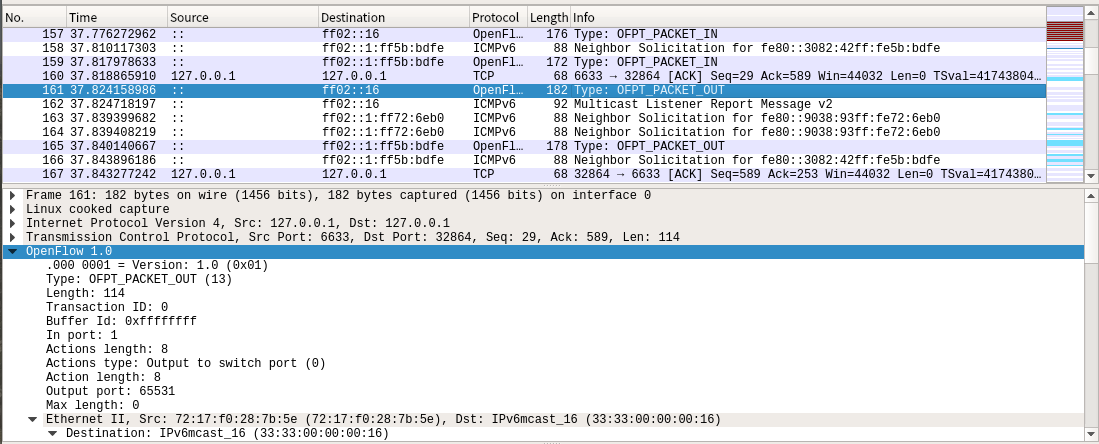
结合Packet_out的结构
struct ofp_packet_out {
struct ofp_header header;
uint32_t buffer_id; /*交换机缓存区id,如果为-1则指定的为packet-out消息携带的data字段*/
uint16_t in_port; /*如果buffer_id为‐1,并且action列表中指定了Output=TABLE的动作,in_port将作为data段数据包的额外匹配信息进行流表查询*/
uint16_t actions_len; /*action列表的长度,可以用来区分actions和data段*/
struct ofp_action_header actions[0]; /*动作列表*/
uint8_t data[0]; /*数据缓存区,可以存储一个以太网帧,可选*/
}
告诉输出到交换机的65531端口
OpenFlow 1.0
.000 0001 = Version: 1.0 (0x01)
Type: OFPT_PACKET_OUT (13)
Length: 114
Transaction ID: 0
Buffer Id: 0xffffffff
In port: 1
Actions length: 8
Actions type: Output to switch port (0)
Action length: 8
Output port: 65531
Max length: 0
Ethernet II, Src: 72:17:f0:28:7b:5e (72:17:f0:28:7b:5e), Dst: IPv6mcast_16 (33:33:00:00:00:16)
Internet Protocol Version 6, Src: ::, Dst: ff02::16
Internet Control Message Protocol v6
接下来是另一台交换机(端口35536)与控制器(端口6633)的交互过程
h1 ping h2
1.packet_in
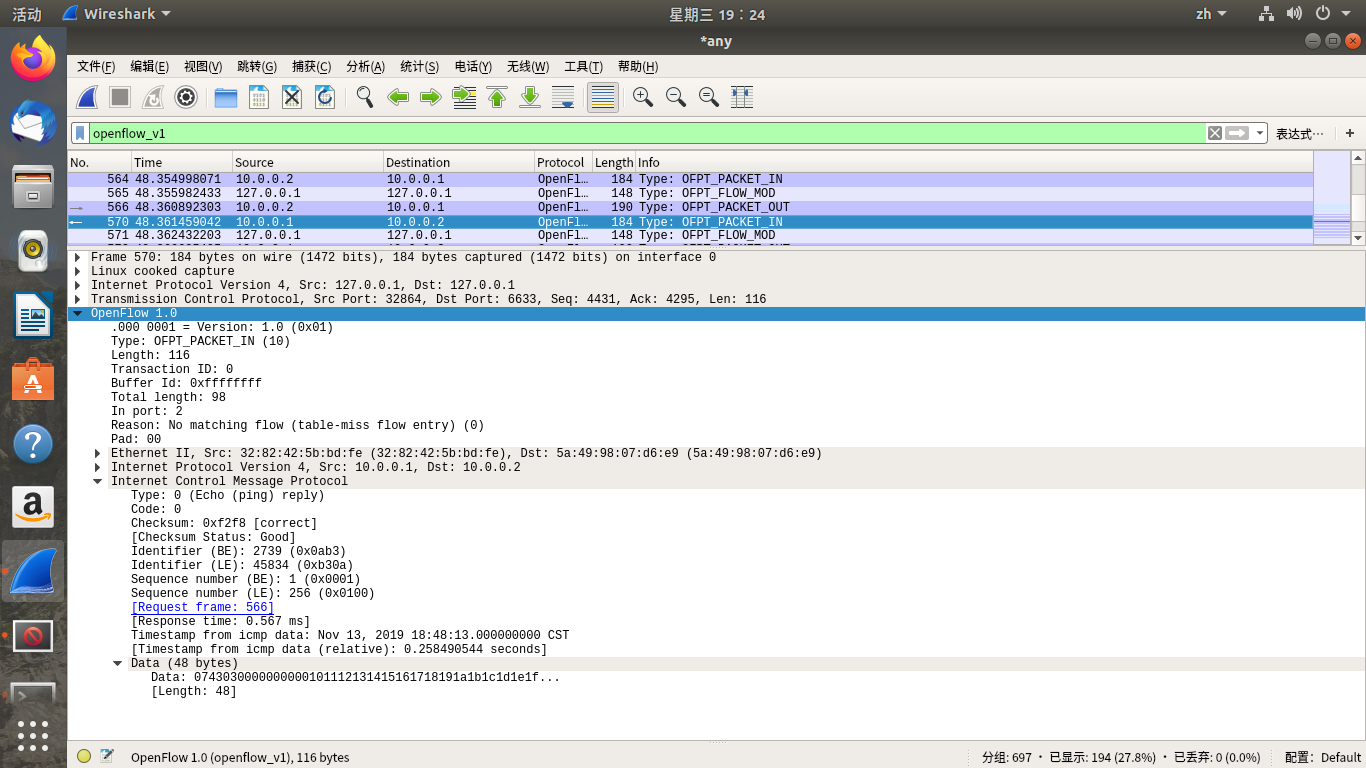
2.flow_mod
结合flow_mod结构
struct ofp_flow_mod {
struct ofp_header header;
struct ofp_match match; /*流表的匹配域*/
uint64_t cookie; /*流表项标识符*/
uint16_t command; /*可以是ADD,DELETE,DELETE-STRICT,MODIFY,MODIFY-STRICT*/
uint16_t idle_timeout; /*空闲超时时间*/
uint16_t hard_timeout; /*最大生存时间*/
uint16_t priority; /*优先级,优先级高的流表项优先匹配*/
uint32_t buffer_id; /*缓存区ID ,用于指定缓存区中的一个数据包按这个消息的action列表处理*/
uint16_t out_port; /*如果这条消息是用于删除流表则需要提供额外的匹配参数*/
uint16_t flags; /*标志位,可以用来指示流表删除后是否发送flow‐removed消息,添加流表时是否检查流表重复项,添加的流表项是否为应急流表项。*/
struct ofp_action_header actions[0]; /*action列表*/
};
分析抓取的flow_mod数据包,控制器通过6633端口向交换机32862端口、交换机32864端口下发流表项,指导数据的转发处理



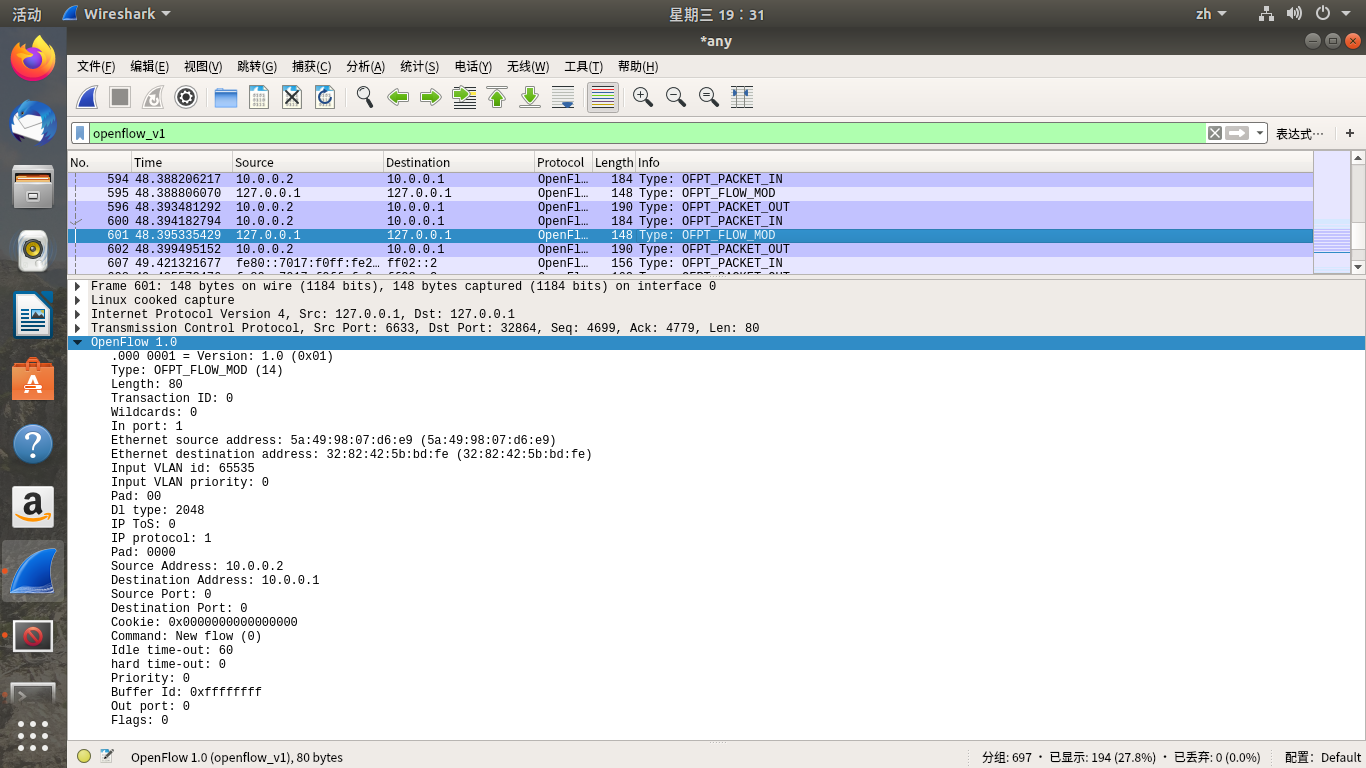
PS.把控制器从openflow reference改成ovs controller
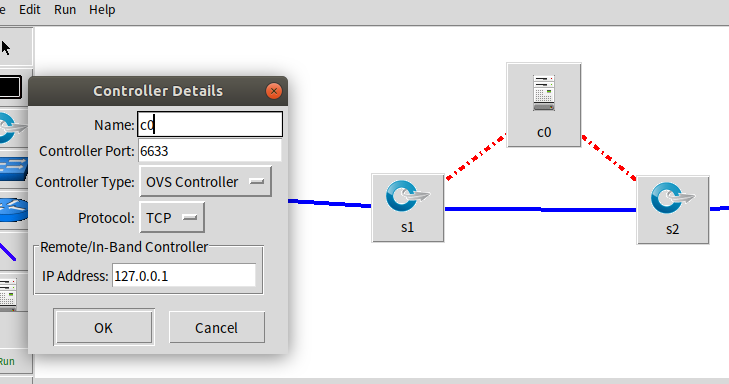
在hello报文中可以发现控制器支持的OpenFlow版本从1.0变成了1.3,因此,经过协商交换机和控制器之间将通过1.3版本的OpenFlow协议进行通信


SDN上机第三次作业的更多相关文章
- 2019 SDN上机第三次作业
2019 SDN上机第三次作业 实验一 利用Mininet仿真平台构建如下图所示的网络拓扑,配置主机h1和h2的IP地址(h1:10.0.0.1,h2:10.0.0.2),测试两台主机之间的网络连通性 ...
- 2019 SDN上机第7次作业
2019 SDN上机第7 次作业 basic补充`/* -- P4_16 -- */ include <core.p4> include <v1model.p4> const ...
- 2019 SDN上机第6次作业
2019 SDN上机第6次作业 1.实验拓扑 (1)实验拓扑 (2)使用Python脚本完成拓扑搭建 from mininet.topo import Topo from mininet.net im ...
- 2019 SDN上机第5次作业
2019 SDN上机第5次作业 1.浏览RYU官网学习RYU控制器的安装和RYU开发入门教程,提交你对于教程代码的理解,包括但不限于: 描述官方教程实现了一个什么样的交换机功能? 答:官方教程实现了一 ...
- 2019 SDN上机第四次作业
2019 SDN上机第4次作业 1. 解压安装OpenDayLight控制器(本次实验统一使用Beryllium版本) 修改环境变量 2. 启动并安装插件 3. 用Python脚本搭建如下拓扑,连接O ...
- SDN上机第五次作业
2019 SDN上机第五次作业 1.浏览RYU官网学习RYU控制器的安装和RYU开发入门教程,提交你对于教程代码的理解,包括但不限于: 1.1描述官方教程实现了一个什么样的交换机功能? 答:官方教程实 ...
- 2019 SDN上机第1次作业
一.安装轻量级网络仿真工具Mininet 克隆github上的Mininet源 git clone https://github.com/mininet/mininet 选择默认全部安装 cd min ...
- 2019 SDN上机第六次作业
1.实验拓扑 (1)实验拓扑 (2)使用python脚本完成拓扑搭建 from mininet.topo import Topo class Mytopo(Topo): def __init__(se ...
- 2019 SDN上机第五次作业
1.浏览RYU官网学习RYU控制器的安装和RYU开发入门教程,提交你对于教程代码的理解,包括但不限于: 描述官方教程实现了一个什么样的交换机功能? 实现将接收到的数据包发送到所有端口 控制器设定交换机 ...
随机推荐
- JavaScript实现网页回到顶部效果
在浏览网页时,当我们浏览到网页底部,想要立刻回到网页顶部时,这时候一般网页会提供一个回到顶部的按钮来提升用户体验,以下代码实现了该功能 HTML代码: <p id="back-top& ...
- js流程控制语句(三)
如果在语句中需要声明变量时:最好给他们赋予初始类型值[js中变量声明使用var属于弱类型声明,若只声明则均表示为undefined,在后面语句计算中可能会产生错误计算];相应的类型变量需要如下方式进行 ...
- node连接Mysql报错ER_NOT_SUPPORTED_AUTH_MODE
报错信息 本人系统安装的是mysql-installer-community-8.0.18.0.msi这个版本,然后我本地使用node-mysql去连接数据库. test.js文件 var mysql ...
- Flask整合WebLoader 用于大附件拆分上传再合并
博客:https://blog.csdn.net/jinixin/article/details/77545140 github:https://github.com/jinixin/upload-d ...
- MySQL备份,使用xtrabackup备份全实例数据时,会造成锁等待吗?那么如果使用mysqldump进行备份呢?
一.xtrabackup和mysqldump会造成锁等待吗? xtrabackup会,它在备份时会产生短暂的全局读锁FTWL(flush table with read lock),用于拷贝frm/M ...
- Java开发环境之Eclipse
查看更多Java开发环境配置,请点击<Java开发环境配置大全> 拾壹章:Eclipse安装教程 1)去官网下载安装包 http://www.eclipse.org/downloads/ ...
- 05-jQuery介绍
本篇主要介绍jQuery的加载.jquery选择器.jquery的样式操作.jQuery的事件.jquery动画等相关知识. 一.jQuery介绍 jQuery是目前使用最广泛的javascript函 ...
- MySQL/MariaDB数据库的并发控制
MySQL/MariaDB数据库的并发控制 作者:尹正杰 版权声明:原创作品,谢绝转载!否则将追究法律责任. 一.并发控制概述 1>.什么是并发控制 MySQL是一个服务器级别的数据库,它通常 ...
- linux命令提示符上色
vi /etc/profile RED='\[\e[31;1m\]' Yello='\[\e[33;1m\]' Green='\[\e[32;1m\]' End='\[\e[0m\]' Pur='\[ ...
- 前端性能----页面渲染(DOM)
CSS会阻塞渲染树的构建,不阻塞DOM构建,但是在CSSOM构建完成之前,页面不会开始渲染(一片空白),CSSOM构建完成后,页面将会显示出内容. DOM(Document Object Model) ...
